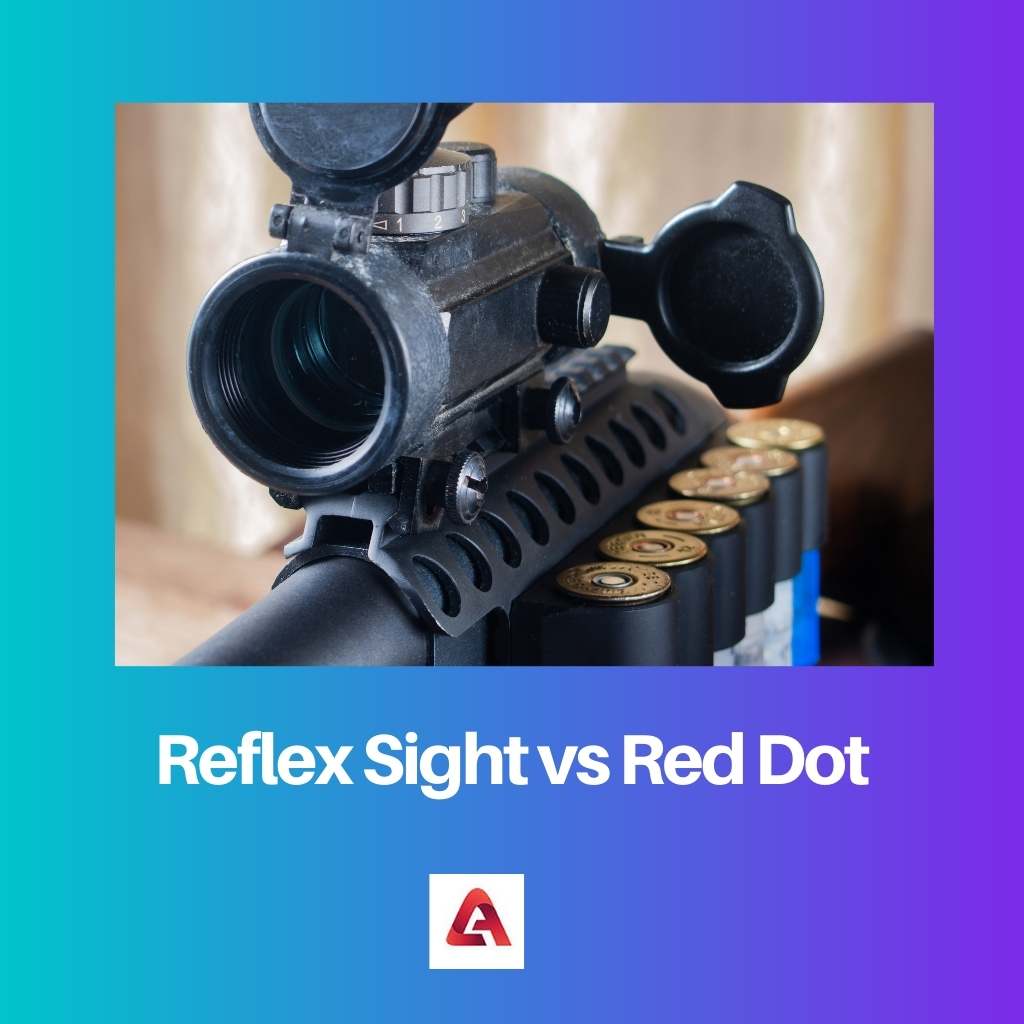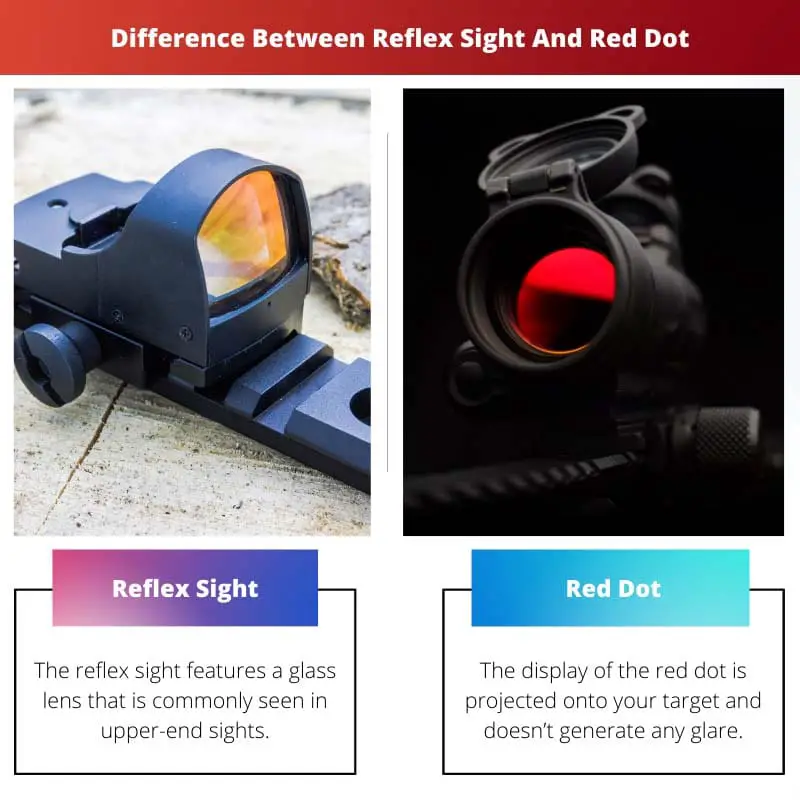Reflex sights and red dots are the most common kinds of gun sight on the market. While both sights are utilized for speedy target acquisition, thus it might be hard to determine which one you require for your purposes.
However, open in different machines, reflection light and red dab sight are of higher importance in most current clash and combat zone hardware.
Target points are crucial in delivering assaults by both sides and can only be obtained by current, fully equipped weaponry.
Key Takeaways
- Reflex sights use a combination of LED and reflective optics to create a reticle, while red dot sights project an LED dot onto a lens.
- Reflex sights are compact and lightweight, making them ideal for handguns and tactical rifles, whereas red dot sights are more versatile and can be used with various firearms.
- Reflex sights offer a wider field of view and faster target acquisition, while red dot sights provide precise aiming and better accuracy.
Reflex Sight vs Red Dot
A reflex sight projects an aiming point, a red dot, onto a small, partially reflecting mirror or lens. A red dot sight uses a small LED to project a red dot onto a reflective lens, which is then reflected back to the shooter’s eye. Red dot sights are more versatile than reflex sights.

The reflex sight is an optical sight that reflects a reticle or picture composed of glass, enabling the targets’ superimposition. It is a non-enhancing kind of sight that may be found on different weapons, telescopes, and still cameras.
Some huge military associations support the utilization of reflex sights for the exactness, quality, strength, accommodation, and better execution it offers.
A red spot sight is a non-customary locating system that superimposes a little (around 1-2 millimetres) red pointing point or specks onto the objective.
It could be projected onto the focal point by using a laser pillar. Lit LED, a focal point, may focus on the spot or a genuine mirror before the LED gets together.
Comparison Table
| Parameters Of Comparison | Reflex Sight | Red Dot |
|---|---|---|
| Lens | The reflex sight features a glass lens that is commonly seen in upper-end sights. | The display of the red dot is projected onto your target and doesn’t generate any glare. |
| Magnification | It can Magnify targets. | It cannot magnify anything. |
| Field of view | Reflex sights have an extensive field of vision. | Red dots do not have an extensive field of vision. |
| Price | More Expensive. | Cheap. |
| Replacements | Replacement of Parts is not easy to find. | Replacement of parts is easy to find. |
What is Reflex Sight?
A reflex sight utilizes a reflecting glass focal point to collimate light from a LED to go about as a pointing point while empowering the client to simultaneously see the field of vision.
The reflecting plan of a reflex sight is direct, comprising a few base parts—a goal focal point, a light-transmitting diode, and a carved stomach (if material).
A reflector sight’s genuine focal point or objective gap is the shooter’s straightforward focal point while pointing.
The focal point is oftentimes positioned at a point to direct collimated light, the reticle, towards the shooter’s eye.
The internal surface of the focal point towards the shooter is covered with an intelligent covering to extend the reticle toward the vibe of the shooter.
The focal point’s outside surface confronting away from the shooter is covered with an enemy of intelligent covering to build reticle permeability.
The light-emitting diode is the source of the reticle picture. Using simply the LED to produce the reticle provides an essential dot. Incorporating an etched diaphragm prevents the transmission of light except via the aperture. As light from the LED is masked off, the remaining light takes the form of the design of the aperture, the shape of a reticle. Reflex sights come into two categories—open and tube sights.

What is Red Dot?
A red dot sight is an optic primarily employed at closer ranges, about 100 yards or fewer.
They are exceedingly straightforward to use and may benefit first-time shooters with more simplified aiming. Red dots are precise as they sound, having a red dot as the reticle when you gaze through this gadget.
Red dot sights commonly employ a red LED. This permits the red dot reticle to remain in alignment with your rifle regardless of eye position. A red dot is constructed of a slanted spherical mirror that reflects the red LED.
This mirror has a special coating that only enables red light to pass through the moniker “red dot” sight. This helps you readily see where you are shooting against darker backdrops or in the woods where it’s green.
The LED light uses extremely little energy, enabling red dots to endure hundreds or tens of thousands of hours, depending on the brightness level. Many variables impact the shooting range of a red dot sight.
Some of these parameters include the size of the dot, the surroundings, daylight availability, the size of the target, and more. A red dot sight can easily aim at a target 100 yards away, if not more.

Main Differences Between Reflex Sight And Red Dot
- The reflex sight features a glass lens that is commonly seen in upper-end sights. They are more costly, have better quality lenses, and have downsides, like glare and fogging while you are out in the rain or snow. Conversely, Red dots will not achieve this since they send an image via a tube onto an illuminated screen.
- Red dots are regarded to be a superior option of optics for shooting at extended ranges. Red dots have a bigger reticle, making it impossible to see your target if you’re looking through a scope at anything over 100 yards or so. While If you are going hunting with a range of more than 200 yards, then a reflex sight isn’t the ideal option for an optic.
- Reflex sight reflects a reticle or image in a matched glass for the superimposition of targets. In contrast, the red dot sight utilizes a tube and provides a red dot instead of a crosshair over the target.
- Red dots may not be as helpful for long-range targets because of their restricted field of vision. Most red dot sights are constructed with a circular field of vision that allows you to see roughly 35 degrees at 100 yards in front of your rifle. While reflex sights offer more broad fields of vision and higher magnification, they will also have shorter battery life than a red dot sight and are a lot more costly.
- The reflex sight is recommended for its accuracy, quality, durability, ease, and excellent performance, whereas a red dot sight is favoured for its extended battery life and simplicity of use.

- https://www.taylorfrancis.com/chapters/edit/10.4324/9781315637501-17/red-dot-sight-colin-milburn-rita-raley
- https://www.spiedigitallibrary.org/conference-proceedings-of-spie/6558/655805/The-off-axis-viewing-device–a-rifle-mounted-sighting/10.1117/12.726331.short

This article is an excellent resource for anyone seeking to understand the differences between reflex sight and red dot. The knowledge and research presented here are invaluable.
The in-depth explanations about the reflex sight and red dot sight give a clear understanding of the inner workings and how they differ. The technical details are very well explained.
The contrast between reflex sight and red dot is very informative. It helps the reader understand the specific use cases and technical aspects thoroughly.
It’s clear to see the benefits of both reflex sights and red dots. The article provides a comprehensive overview of what to consider when choosing between them.
I found the information about red dots especially helpful. The explanation of how they function and their suitability for different purposes is very insightful.
Absolutely fascinating article! The information provided is very clear and concise. I love the comparison table, it highlights the key differences perfectly.